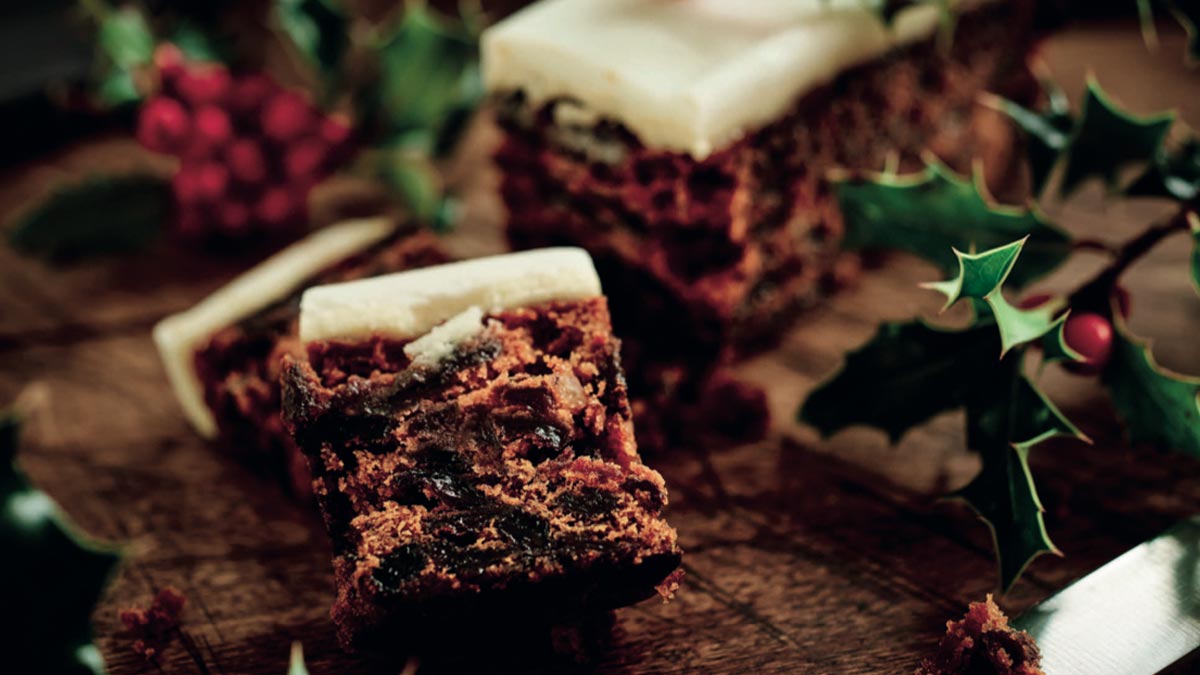I have a love/hate relationship with Christmas cake. On the one hand, I enjoy a slice with tea or coffee after the mandatory left-over turkey and ham sandwich at lunch in those lazy days after Christmas Day. On the other hand, the richness of the fruit cake soon catches up with me and I get a dire need for one of what the EMA delicately calls Species Digestivae in order to relieve my symptoms. Herbs such as fennel, chamomile or mint are useful for “the symptomatic relief of mild dyspeptic/gastrointestinal disorders including bloating and flatulence”. So, apart from the inevitable weight gain and the aforementioned digestive issues are there any other health effects linked to Christmas cake?
In answering that question, I will ignore the pharmacological impact of the mixed spice blend of cinnamon, coriander seed and nutmeg used to flavour the cake because I have dealt with those spices over the years. I will also omit comment on the possible anti-oxidant properties of the dried grapes (currants, raisins and sultanas) that are among the key ingredients. Instead I am going to concentrate on the icing that is an integral part of any self-respecting cake. Doing so raises several dilemmas that frequently arise in the Corrigan household; whether royal or fondant white icing is used is one, but much more important is the question as to whether almond paste or marzipan is used as the base layer for the icing sugar. Higher management is firmly on the side of almond paste and woe betide anybody foolish enough to suggest shop-bought marzipan as an alternative.
Now you might wonder if there is any difference given that both marzipan and the paste both contain powdered almonds but there is a distinction between them. Marzipan consists of sugar, honey, ground almonds and sometimes almond oil. Apart from its use on Christmas and Simnel (Easter) cakes, it is also made into sweets and two marzipans have protected status within the EU, one from Toledo in Spain and the other from Lübeck in Germany. Almond paste according to my higher management is made with ground almonds, sugar, egg yolk and sherry. It is claimed that it has a higher percentage of almonds than marzipan; up to 50% compared to about 28% in the latter. So, this article is really about the health effects, both good and bad, associated with almonds.
Although native to Iran, more than half of the world’s annual production of four million tonnes comes from California with the rest coming from Spain, Australia, Iran, Turkey and Morocco. Almonds are, of course, the seed or nut from Prunus amygdalus and one of the key chemicals in it is duly called amygdalin. When this breaks down by means of an enzyme inevitably called prunase, it gives rise to the characteristic smell of almonds due to benzaldehyde, one of the metabolites along with hydrogen cyanide (HCN) of which more later. The other key component is a fatty oil that constitutes about 50% of the dry mass of the seed kernel. This oil is rich in oleic, linoleic and palmitic acids.
Many RCTs have been conducted with almonds. In 2016, the Journal of Nutritional Science included a Canadian systematic review and meta-analysis of RCTs on the effects of almond consumption on fasting blood lipids. A total of 18 studies were included where participants consumed between 20 and 113g per day of whole, raw unpeeled (unblanched), unsalted almonds for up to 18 months. The outcomes measured included total cholesterol, LDL-cholesterol, HDL-cholesterol, triacylglycerols (TAG) and the ratios of LDL- to total cholesterol and HDL-to total cholesterol. The meta-analysis revealed that total, LDL-cholesterol and TAG levels were significantly reduced but HDL levels were not affected. The authors commented that the results were consistent with those of observational studies and a recent large-scale intervention study that showed that consumption of nuts reduces the risk of heart disease.
Two further systematic reviews and meta-analyses published in Phytotherapy Research in 2022 gave conflicting results. In one, patients with Type-2 diabetes were enrolled in nine RCTs. While almond consumption gave a significant reduction in LDL-cholesterol compared to controls, effects on other cardiometabolic risk factors such as HDL, triglycerides, fasting plasma glucose, HbA1c, C-Reactive Protein, BP and BMI were not significant. The second paper dealt with the results of 26 trials on the effect of almond intake on cardiometabolic risk factors, inflammatory markers and liver enzymes. This found that almond intake significantly decreased diastolic BP, total and LDL-cholesterol and triglyceride levels. Just as in the previous meta-analysis effects on other cardiometabolic risk factors were not statistically significant. The authors were of the belief that the current level of evidence supported the consumption of almonds for their lipid-lowering and hypertensive effects.
The current level of evidence supported the consumption of almonds for their lipid-lowering and hypertensive effects
Notwithstanding that positive health assessment, the story of almonds does have a darker side linked to the cyanide content of the kernels as any devotee of Agatha Christie will know. A paper in ISRN Toxicology in 2013 reported on potentially toxic levels of cyanide in almonds. The level in sweet almonds was much lower at 25mg/kg than in bitter almonds, which contained 1062 mg/kg. Most trees produce sweet almonds but some individual trees are genetically predisposed to produce seeds that are bitter. The reason sweet almonds are low in cyanide in the form of amygdalin is due to plant breeding effects according to a fact sheet on cyanogenic glycosides prepared for the New Zealand Food Safety Authority. Noting that bitter almonds could provide up to 4.7mg/kg of cyanide, the fact sheet is reassuring in that it claims that the procedures used in the preparation of marzipan should eliminate most of the cyanide.
Amygdalin has achieved notoriety through having been misused in the form of a product called Laetrile in some unorthodox cancer treatments where unsuspecting patients were led to believe that the cyanide generated from large doses of injected and oral Laetrile could selectively poison cancer cells while leaving healthy tissues unscathed. Utter rubbish, of course, and the risks to patient safety were unsurprisingly high. A 1982 paper in the Western Journal of Medicine reported on one bowel cancer sufferer who self-administered injectable Laetrile from a Mexican laboratory and then ingested it in tablet form over a six-month period after eating four to five bitter almonds the patient collapsed and it was estimated that they had been exposed to 75mg of cyanide in one go. While the almond saga is not therefore all sweetness and light, the food safety advice should reassure you that whether you have almond paste or marzipan on your Christmas cake it will not poison you. I hope you enjoy not only your cake but the rest of your Christmas and your new year.
Dr Des Corrigan, Best Contribution in Pharmacy Award (winner), GSK Medical Media Awards 2014, is a former Director of the School of Pharmacy at TCD and won the Lifetime Achievement Award at the 2009 Pharmacist Awards. He was chair of the Government’s National Advisory Committee on Drugs from 2000 to 2011. He currently chairs the Advisory Subcommittee on Herbal Medicines and is a member of the Advisory Committee on Human Medicines at the IMB. He is a National Expert on Committee 13B (Phytochemistry) at the European Pharmacopoeia in Strasbourg and he is an editorial board member of the Journal of Herbal Medicine and of FACT — Focus on Alternative and Complementary Therapy.







